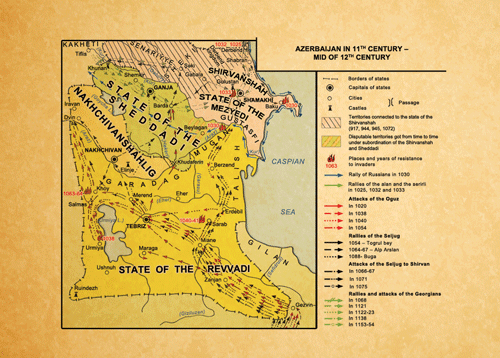"HEYDƏR ƏLİYEV İRSİ"
BEYNƏLXALQ ELEKTRON KİTABXANA
"HEYDAR ALIYEV HERITAGE"
INTERNATIONAL ONLINE LIBRARY
- Library is a holy temple for the people and nation, it is the source of knowledge, wisdom and spirituality
H. Aliyev
H. Aliyev
Shaddadids state
 The Shaddadid dynasty, who played an active role in the military and political history of Azerbaijan and neighboring countries, was in power in the Southern Caucasian emirates of Ganja, Nakhichevan, Dvin, and Ani from the mid pf the 10th century until the end of the 12th century. Using the difficult situation in the Salarid state in 951, the founder of the Kurdish Shaddadid dynasty Muhammad bin Shaddadid, as well as his sons Abulhasan Ali Lashkari and Fazl expanded the struggle for the lands possessed by the Salarids. In 971, Lashkari took power in Ganja with the help of his brother Fazl, who was serving the Salarids. Thus, the Shaddid state was established with its capital in Ganja. According to the treaty concluded after the unsuccessful siege of Ganja by the Salarid ruler Ibrahim the most part of Arran (Barda, Shamkir, Nakhichevan and other lands) passed to the Shaddadids. The Seljuqs put an end to the existence of the Shaddadid state in 1075.
The Shaddadid dynasty, who played an active role in the military and political history of Azerbaijan and neighboring countries, was in power in the Southern Caucasian emirates of Ganja, Nakhichevan, Dvin, and Ani from the mid pf the 10th century until the end of the 12th century. Using the difficult situation in the Salarid state in 951, the founder of the Kurdish Shaddadid dynasty Muhammad bin Shaddadid, as well as his sons Abulhasan Ali Lashkari and Fazl expanded the struggle for the lands possessed by the Salarids. In 971, Lashkari took power in Ganja with the help of his brother Fazl, who was serving the Salarids. Thus, the Shaddid state was established with its capital in Ganja. According to the treaty concluded after the unsuccessful siege of Ganja by the Salarid ruler Ibrahim the most part of Arran (Barda, Shamkir, Nakhichevan and other lands) passed to the Shaddadids. The Seljuqs put an end to the existence of the Shaddadid state in 1075.
